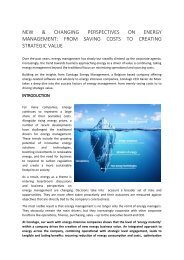Accurate Allocation of energy in production processes - the importance of using metamodels
Many companies struggle with correctly monitoring, allocating and distributing direct and indirect energy consumption over all internal and external customers, users or products. In this age of rising commodity costs and additional attention to sustainability, the advantages of adequately allocating energy are nonetheless substantial: 1. Real-time mapping of energy throughout process flows makes it easier to detect deviations in energy conversions during production processes, find the root causes and reduce losses. 2. Using exact and objective keys for allocating energy consumption speeds up periodic P&L and CSR reporting and makes for more accurate reports. 3. Continuous, real-time distribution of energy cost among users increases transparency and raises awareness with them. Although most companies already struggle with integrating correct data from metered equipment, this is only the first - albeit important - step. The crux is fully understanding the nature and efficiency of energy conversions processes; energy inflows and outflows to different customers; fixed and variable costs and corporate structures. By using metamodels - designed for and maintained by energy managers - all this information is added to the initial metered data and processed in such a way that any change from an energy point of view instantly leads to adjustments in the energy allocation. This white paper reviews emerging trends and challenges in energy allocation and examines the working and benefits of using specific metamodels at the level of energy management software.
Many companies struggle with correctly monitoring, allocating and distributing
direct and indirect energy consumption over all internal and external customers,
users or products. In this age of rising commodity costs and additional
attention to sustainability, the advantages of adequately allocating energy are
nonetheless substantial:
1. Real-time mapping of energy throughout process flows makes it easier
to detect deviations in energy conversions during production processes,
find the root causes and reduce losses.
2. Using exact and objective keys for allocating energy consumption
speeds up periodic P&L and CSR reporting and makes for more accurate
reports.
3. Continuous, real-time distribution of energy cost among users increases
transparency and raises awareness with them.
Although most companies already struggle with integrating correct data from
metered equipment, this is only the first - albeit important - step. The crux is
fully understanding the nature and efficiency of energy conversions processes;
energy inflows and outflows to different customers; fixed and variable costs
and corporate structures. By using metamodels - designed for and maintained
by energy managers - all this information is added to the initial metered data
and processed in such a way that any change from an energy point of view
instantly leads to adjustments in the energy allocation.
This white paper reviews emerging trends and challenges in energy allocation
and examines the working and benefits of using specific metamodels at the
level of energy management software.
Create successful ePaper yourself
Turn your PDF publications into a flip-book with our unique Google optimized e-Paper software.
A brief history <strong>of</strong> <strong>energy</strong> management tools<br />
Craft<strong>in</strong>g appropriate distribution keys is <strong>of</strong>ten a tedious task that is undertaken<br />
once a year - with meticulous attention to details and hard work. Without <strong>the</strong><br />
appropriate s<strong>of</strong>tware tools, it is almost impossible to monitor <strong>the</strong>ir evolution<br />
permanently.<br />
Over <strong>the</strong> last ten years, <strong>the</strong> market for dedicated <strong>energy</strong> bookkeep<strong>in</strong>g s<strong>of</strong>tware<br />
has grown and <strong>the</strong>re are now a number <strong>of</strong> applications for collect<strong>in</strong>g, validat<strong>in</strong>g<br />
and report<strong>in</strong>g meter<strong>in</strong>g data. Most <strong>of</strong> <strong>the</strong> 156 <strong>energy</strong> management packages<br />
referred to above, <strong>in</strong>deed provide real-time monitor<strong>in</strong>g.<br />
When it comes to provid<strong>in</strong>g <strong>in</strong>sights and l<strong>in</strong>k<strong>in</strong>g meter<strong>in</strong>g data to <strong>the</strong><br />
organisation structure, however, only a very small number <strong>of</strong> those packages<br />
provide <strong>the</strong> option to do so. Deal<strong>in</strong>g with chang<strong>in</strong>g structures proved even<br />
more problematic, as none <strong>of</strong> those applications provided an option to take<br />
<strong>in</strong>to account chang<strong>in</strong>g structures without heavy custom development.<br />
Tak<strong>in</strong>g <strong>in</strong>to account <strong>energy</strong> conversions and allocation <strong>energy</strong> throughout such<br />
<strong>processes</strong>, turned out to be an even greater challenge that none <strong>of</strong> <strong>the</strong>m could<br />
address.<br />
The fundamental reason for <strong>the</strong>se shortcom<strong>in</strong>gs, is <strong>the</strong> lack <strong>of</strong> an adequate<br />
metamodel at <strong>the</strong> core <strong>of</strong> <strong>the</strong> current generation <strong>of</strong> <strong>energy</strong> management<br />
s<strong>of</strong>tware. Such a metamodel provides all contextual <strong>in</strong>formation that is needed<br />
to <strong>in</strong>terpret raw meter<strong>in</strong>g data. It describes <strong>the</strong> structure <strong>of</strong> <strong>energy</strong> flows<br />
(<strong>in</strong>flows, conversion, outflows); <strong>the</strong> structure <strong>of</strong> <strong>the</strong> company (<strong>the</strong> organisation<br />
chart); and <strong>the</strong> position <strong>of</strong> key people (those with responsibilities, as <strong>the</strong>y will<br />
need dedicated periodic reports) with<strong>in</strong> it.<br />
The <strong>metamodels</strong> <strong>in</strong> <strong>the</strong> s<strong>of</strong>tware - which were present <strong>in</strong> only a fraction <strong>of</strong><br />
<strong>the</strong> packages to beg<strong>in</strong> with - are hierarchical and static. A hierarchical model<br />
would give each asset a fixed position with<strong>in</strong> a set structure, where it belongs<br />
to one and only one higher category (e.g. a meter belongs to a build<strong>in</strong>g, which<br />
<strong>in</strong> turn could be part <strong>of</strong> a site). Energy conversions, however, break this mould<br />
as several commodities - and thus <strong>the</strong>ir meter read<strong>in</strong>gs - are comb<strong>in</strong>ed and<br />
recomb<strong>in</strong>ed <strong>in</strong> different configurations. As <strong>the</strong> models are also static <strong>the</strong>y are<br />
not aware <strong>of</strong> any changes that may have occurred, impair<strong>in</strong>g <strong>the</strong> ability to draw<br />
conclusions.<br />
All this po<strong>in</strong>ts at <strong>the</strong> dawn <strong>of</strong> a new generation <strong>of</strong> <strong>energy</strong> management s<strong>of</strong>tware,<br />
built around appropriate <strong>metamodels</strong> and able to allocate <strong>energy</strong> <strong>in</strong> chang<strong>in</strong>g,<br />
process-based sett<strong>in</strong>gs.<br />
7




